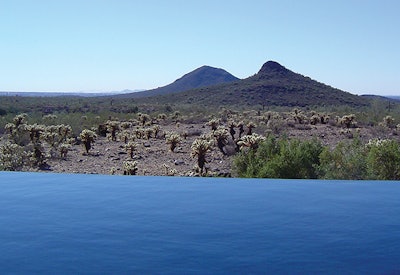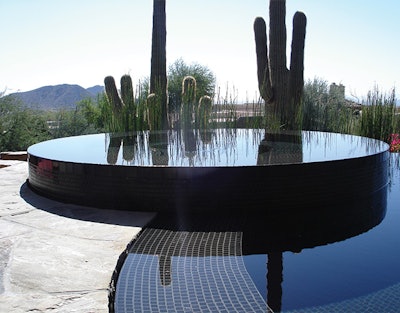
There's drama and an almost sculptural beauty in desert landscapes. Cacti, succulents and hearty brush plants cling to expansive flats, craggy mountains and deep arroyos struggle to draw and collect enough water to support life — all amid the intense heat, violent winds, blowing sand and intermittent cold that combine to form a forbidding but strangely delicate desert world.
A pool placed here can be the most compelling of vessels found anywhere, both for its powerful aesthetics (as depicted on this webpage) and the sheer luxuriant pleasure of lolling in abundant water in a hot, dry place.
The desert world is a land of sharp contrasts — light and shadow, scorched land and blue sky — and making aquatic spaces here means working those contrasts into a single, integrated whole, starting with the simple, stark contrast between the water itself and the desert landscape.
"You can use that contrast to great effect. It's what the vanishing look is all about, as an example. It brings those contrasting elements together," says Kevin Woodhurst, senior design consultant for Caribbean Pools in Chandler, Ariz.
Woodhurst has been designing and building pools in the Arizona desert for more than 20 years. There was a time, he recalls, when creating naturalistic desert oases was in vogue. In recent years, however, Woodhurst reports that nearly all of his clients are looking for contemporary designs that are far more simplistic aesthetically, and that visually juxtapose the water with the landscape rather than try to mimic it.
"What most people are looking for is the contemporary look with almost harsh angles that stand out as architectural statements in the environment. It creates this wow moment where you're inherently drawn to the water and the contrast it creates," he says. "It's not a natural environment for a body of water and the desert is in effect framing it. That makes the water look so much more spectacular.
"If you take a given pool design and insert it into different backdrops, you can see how different the exact same pool can look based entirely on the environment it's built in," he adds. "That intense contrast has always been fascinating to me. With contemporary design, we see a lot more concrete, glass and girders. There are massive windows and massive doors that bring the inside outside and vice versa. It all works so well because it's so out of place."
Although contemporary design is currently popular in the works of architectural masters like Frank Lloyd Wright, it was also widely popularized in mid-century modern, or "Martini modern" designs.
"But back then there wasn't the technology that we have now to create design, so now we're able to expand on that concept with more creative modern designs that incorporate different shapes, materials and layouts," Woodhurst says. "It's an exciting time to be working because of the flexibility of design technology. The possibilities now are almost infinite."
RELATED: A Desert Oasis
 The perfect geometric lines of this spillover spa are accentuated by the random perfection of the surrounding desert landscape, a popular and powerful design strategy.
The perfect geometric lines of this spillover spa are accentuated by the random perfection of the surrounding desert landscape, a popular and powerful design strategy.
Above photo courtesy of Kevin Woodhurst
DRY PRACTICALITY
Apart from the dynamic aesthetic possibilities, Woodhurst says working in the desert also means understanding the effects of the often-extreme conditions.
"There's huge amount of evaporation here," he says. "Every pool evaporates about 6 feet per year, so every play pool, for example, loses its entire volume to evaporation every year. That's part of why water chemistry can be so problematic: because the evaporation removes pure water but leaves behind all the solids."
The high evaporative rates make a strong case for automatic pool covers, and can also mean thinking judiciously about some types of water features. "If you take a water feature such as a vanishing edge weir, the amount of evaporation becomes even more massive," Woodhurst says. "We also look at things like placement in yard, because we get so much wind here, which can deposit dust and dirt in large quantities. We're also thinking about shade and sun exposure.
"In the desert you have to be constantly thinking about all those factors. It's a beautiful environment, but it's also very demanding."
IN THE HEAT OF TEXAS
For several years running, parts of Texas have been among the hottest markets for home improvements, and especially so for pool designers and builders. Michael Logsdon, president of Land Design, located in Boerne, has extensive experience designing and building landscapes and pools that take cues from the various climate zones, including many that are directly inspired by the parched flatlands of the state's driest areas.
"Our area is technically semi-arid, but it certainly has what most people would consider a desert-like feeling to it," he says. "One key to designing in this type of landscape is to try to work with native plants and stone materials as much as possible. Indigenous plants are always going to do better in most any given area and when you're talking about climates where you can go a long time between rain, you want plants that don't need to be watered frequently. It's just common sense."
 Photos courtesy of Splash Pools and Construction
Photos courtesy of Splash Pools and Construction
Below, inset image also courtesy of Splash Pool and Construction
In terms of stone materials, he adds, "You're going to harmonize more easily with the landscape by using types of stones that you find locally. From an aesthetic standpoint, you'll find colors and textures that feel more at home in the landscape. In recent years, we have seen a trend in colors go from beiges, sand and other earth tones to more gray colors, but there are always going to be trends like that coming and going."
 The colors and textures of the American Southwest are reflected in this suburban backyard oasis where natural and artificial stone structures echo the rugged desert topography.
The colors and textures of the American Southwest are reflected in this suburban backyard oasis where natural and artificial stone structures echo the rugged desert topography.
Just as Woodhurst finds beauty and interest in the contrasts, Logsdon also reports that the presence of water in an otherwise dry landscape can be tremendously compelling. "The contrast comes from the design of the pool itself," he says. "Bodies of water do stand out in the landscape and we've had success moving in a much more simplistic direction because of the way it looks in the setting."
Logsdon often turns to simplistic pool designs to accentuate the contrasts with distinctive geometric shapes. One of his favorite projects, he reports, was a perfectly round raised pool that looks more like a water tank for livestock than it does a swimming pool. The project is located amongst a classic, western/desert landscape and is adjacent to a water tower and windmill.
Altogether, it makes a folksy statement that looks right at home in the desolate setting.
"I really enjoy working with simple shapes," he says. "There's nowhere more dramatic than the desert and these simple pools are a great way to draw attention to the water in settings where water is relatively scarce."
RELATED: The Desert Deep Purple Project
ARID INSPIRATIONS
Like Arizona and West Texas, Southern California is known for its dusty environs. From the vast expanses of the Mohave Desert to the harsh depths of Death Valley, the region is dominated by desert landscapes. But in some fully developed urban areas, the desert has been replaced by tree-lined streets, grassy medians and professional landscaping, and holds little resemblance to the arid scenes found beyond the city limits.
But even in these urban areas that no longer resemble an actual desert, the arid design influence can be felt almost everywhere. Case in point: Splash Pools and Construction, located in Chino, Calif., recently completed a residential project that transports the homeowners to a rocky desert landscape oasis that likely existed not far from the home before civilization moved in.
In their search for professionals who could help make their dream desert oasis backyard a reality the clients turned to landscape designer Nick Williams, who specializes in creating themed yards and outdoor spaces. According to company president Jeff Stephenson, the clients had kept photos of Williams' work on their refrigerator for years until they were in a position to move forward with the project.
"They called Nick when they were ready and asked for his thoughts about what they could do, but he's not a builder," Stephenson explains. "His MO is that he designs and then goes out and oversees everything that's done. He's not someone who just designs a job and then says, 'see ya later.'" Stephenson's firm also offered design ideas to the clients, who eventually settled on a plan where Splash Pools and Construction would work directly with Williams in creating the ambitious design. "They wanted the best of both worlds," Stephenson recalls.
The resulting collaboration led to a space that first and foremost features extensive rockscapes that combine natural stone material and artificial rockwork. "The large stone structures were all built on site; none of these were castings," Stephenson explains. "In a project like this, when you hand-place real rock into the manufactured rock there's no way to do that with castings. The time-consuming part was all the finish work with the coloring, texture and veining. We do a lot of this type of rockwork and natural boulders, but not usually to this extreme."
The plan called for a large 18-by-50 foot vanishing edge pool heavily clad in rockwork, including a large waterfall structure over the deep end, a two-tone pebble finish and artificial rock fire features located on the bond beam and the adjacent landscape. The pool has a pond-like freeform design that appears to share circulation with an existing stream and waterfall. "It looks like it's all a single body of water, but in fact the pool and the stream are completely separate. It's an illusion."
Throughout the yard, the team located numerous planting areas that feature a variety of cacti, succulents and other plant species native to deserts. Combined with the rockwork, the result is a water-wise landscape, a huge advantage in an area prone to drought. Paths and steps with large flat stone pieces and decomposed granite enable easy movement through the complex landscape and offer different focal points across the water and into the surrounding views.
 Juxtaposing luxurious aquatic spaces with arid landscapes affords designers powerful opportunities to create drama, comfort and luxury on the cusp of desolation. (Photo courtesy of Kevin Woodhurst)
Juxtaposing luxurious aquatic spaces with arid landscapes affords designers powerful opportunities to create drama, comfort and luxury on the cusp of desolation. (Photo courtesy of Kevin Woodhurst)
Stephenson reports that the finished design was in a constant state of change throughout the project. "It took about a year, but that's how it can go when you're working in a detailed design," he says. "There were a lot of changes that took place in the field, which is why it took so long. Thankfully the homeowner was willing and had the pocket book to change things along the way."








































